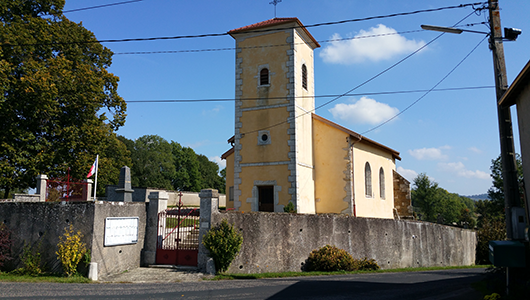Dommarie-Eulmont
Durée visite : 20 minutes
Moyen : Pédestre
Ce beau village offre une très intéressante église. Ses autres traces du passé ont plus souffert. Le château de Dammarie fut propriété des Tavagny-Florainville. Il était construit à proximité immédiate et au nord de l’église de Dommarie. Il fut transformé en ferme. Déjà ruiné en grande partie en 1888, il disparu totalement au début du XXe siècle. Le terrain est propriété de la commune.
Un ancien moulin à huile se trouve à proximité de l’église. Cinq puits sont présents. Quatre sont creusés à Dommarie. Un se trouve à Eulmont.
This beautiful village offers a very interesting church. His other traces of the past have suffered more. The castle of Dammarie was owned by Tavagny-Florainville. It was built in the immediate vicinity and to the north of the church of Dommarie. It was transformed into a farm. Already largely ruined in 1888, it completely disappeared at the beginning of the 20th century. The land is owned by the municipality.
An old oil mill is located near the church. Five wells are present. Four are dug in Dommarie. One is in Eulmont.
Dieses schöne Dorf bietet eine sehr interessante Kirche. Seine anderen Spuren der Vergangenheit haben mehr gelitten. Das Schloss von Dammarie gehörte Tavagny-Florainville. Es wurde in unmittelbarer Nähe und nördlich der Kirche von Dommarie gebaut. Es wurde in eine Farm umgewandelt. Bereits 1888 weitgehend zerstört, verschwand es zu Beginn des 20. Jahrhunderts vollständig. Das Land gehört der Gemeinde.
In der Nähe der Kirche befindet sich eine alte Ölmühle. Es sind fünf Brunnen vorhanden. Vier sind in Dommarie gegraben. Einer ist in Eulmont.

D’azur à la bande ondée d’argent chargée d’une meule de gueules et d’une roue de moulin du même accompagnée en chef d’une tour d’argent maçonnée de sable et en pointe d’un arbre arraché d’argent.
La bande ondée représente le ruisseau qui traverse la localité. La meule et la roue de moulin indiquent successivement le moulin à huile et le moulin à eau du village. La tour symbolise le château de Dommarie Eulmont et les armes de la famille Gournay, seigneur du lieu (trois tours en bande). Enfin, l’arbre symbolise la forêt communale.
Azure, a wavy band Argent charged with a grindstone Gules and a mill wheel of the same accompanied in chief by a tower Argent masoned Sable and in base of a torn off tree Argent .
The wavy band represents the stream that crosses the locality. The grindstone and the mill wheel successively indicate the village oil mill and water mill. The tower symbolizes the castle of Dommarie Eulmont and the arms of the Gournay family, lord of the place (three towers in a band). Finally, the tree symbolizes the communal forest.
Azure, ein gewelltes Band Argent, das mit einem Schleifstein Gules und einem Mühlrad desselben aufgeladen ist, begleitet von einem Turm Argent, der Sable gemauert hat, und auf der Basis eines abgerissenen Baumes Argent .
Das Wellenband repräsentiert den Strom, der die Lokalität durchquert. Der Schleifstein und das Mühlrad zeigen nacheinander die Dorfölmühle und die Wassermühle an. Der Turm symbolisiert das Schloss von Dommarie Eulmont und die Wappen der Familie Gournay, des Herrn des Ortes (drei Türme in einer Bande). Schließlich symbolisiert der Baum den Gemeinschaftswald.
Les points de visites
.
L’église paroissiale de la Nativité de la Vierge est d’une jolie couleur jaune. Le chœur de l’église conserve des vestiges du XVe siècle. Il était autrefois la chapelle du château, au nord, aujourd’hui disparu. La nef date des XVIIIe et XIXe siècles. La sacristie, à l’Est, date de 1883 et le clocher est du XIXe siècle. Pour la visiter, il faut demander la clef aux voisins d’en face. Le Nouveau Testament ne dit rien du lieu ni de la date de naissance de Marie. Il ne dit rien non plus des parents de Marie, ni des circonstances de sa naissance. Ce sont des évangiles apocryphes qui renseignent sur ces éléments.
The parish church of the Nativity of the Virgin is a pretty yellow color. The choir of the church preserves vestiges of the 15th century. It was once the chapel of the castle, to the north, now disappeared. The nave dates from the 18th and 19th centuries. The sacristy, to the east, dates from 1883 and the bell tower is from the 19th century. To visit it, you have to ask for the key to the neighbors opposite.
Die Pfarrkirche der Geburt der Jungfrau hat eine hübsche gelbe Farbe. Der Chor der Kirche bewahrt Überreste des 15. Jahrhunderts. Es war einst die Kapelle der Burg im Norden, die jetzt verschwunden ist. Das Kirchenschiff stammt aus dem 18. und 19. Jahrhundert. Die Sakristei im Osten stammt aus dem Jahr 1883 und der Glockenturm stammt aus dem 19. Jahrhundert. Um es zu besuchen, müssen Sie nach dem Schlüssel für die Nachbarn fragen.
.
.
A quelques dizaines de mètres de l’église, on découvre une belle curiosité artisanale.
Il s’agit d’une reconstitution d’un moulin à huile . Il était actionné par des chevaux sous un abri public. On peut reconnaître les différents éléments, auge, meule, arbre vertical et roue dentée.
A few tens of meters from the church, we discover a beautiful artisanal curiosity. It is a reconstruction of an oil mill. It was powered by horses under a public shelter. We can recognize the different elements, trough, grinding wheel, vertical shaft and toothed wheel.
Ein paar zehn Meter von der Kirche entfernt entdecken wir eine schöne handwerkliche Neugier. Es ist eine Rekonstruktion einer Ölmühle. Es wurde von Pferden unter einem öffentlichen Schutz angetrieben. Wir können die verschiedenen Elemente Trog, Schleifscheibe, vertikale Welle und Zahnscheibe erkennen.







